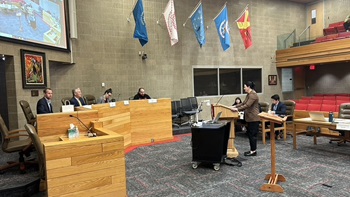USD Biologist Contributes to Major Study on the Transport of Contaminants and Nutrients by Pacific Salmon

Over their lifespan, Pacific salmon can migrate thousands of miles from their spawning grounds in freshwater streams, lakes and rivers to the ocean and back again as they return to their homes to spawn and die. Their bodies, whether decaying after death or caught alive and eaten by predators, release both beneficial nutrients and potentially harmful contaminants into inland ecosystems.
A research team that includes Jeff Wesner, Ph.D., associate professor of biology at the University of South Dakota, examined data collected over 40 years to determine the ecological trade-offs between the nutrients and contaminants these migrating fish bring to freshwater systems after years of eating smaller fish and krill in the ocean.
An article on the team’s findings, “Continental-scale nutrient and contaminant delivery by Pacific salmon,” is published in the journal Nature.
“Everybody knows the life history of salmon,” Wesner said. “Their story is iconic.”
What’s less known is the number of contaminants that accompany the beneficial energy and nutrients the Pacific salmon bring to inland waterways from years in marine based environments, where they gain 95% of their biomass.
Wesner and researchers at the University of Connecticut, the U.S. Geological Survey, Natural Resource Consultants, the University of Saskatchewan, the University of Missouri, and Regis University joined together to analyze published data on five species of Pacific salmon who migrate from freshwaters spanning northern California to western Alaska to the eastern Pacific Ocean and back again.
One of the study’s authors, Gregory T. Ruggerone, Ph.D., a fisheries consultant, had collected data over a 40-year period (1976-2015) that documented the number of Chinook, coho, chum, pink and sockeye salmon that made it back to spawning areas. The research team combined that information with data on the average weight of a fish of each of the five species to determine the population’s total biomass.
Combing through decades of more published studies gave researchers data on concentrations of compounds commonly associated with Pacific salmon. On the nutrient side were nitrogen, phosphorus and beneficial omega-3 fatty acids. The toxic contaminants measured were mercury and the man-made organic chemicals PCBs, DDTs, and PBDEs.
Results of their study showed the biomass of salmon that returned to spawning grounds grew 32% between 1976 and 2015. Correspondingly, nutrient delivery grew 30%, but contaminant delivery grew only 20%.
“The main finding is that the movement of contaminants is lower than expected,” Wesner said. “If you're the bear eating salmon, that salmon, on average, is probably going to be pretty good for you.”
The data also showed that short-lived pink salmon species had the highest percentage of growth over the past three decades, accounting for 80% of the increase in overall biomass.
“One of the bigger patterns is that pink salmon have become a lot more common in the last 30 years” Wesner said. “Pink salmon have the lowest number of contaminants in them because they feed lower on the food chain.”
Chinook salmon, on the other hand, are the highest on the food chain and also have the highest number of contaminants in their bodies.
“The reason that this risk hasn’t gone up exponentially is because the abundance of pink salmon has gotten bigger relative to Chinook,” he said. “The good has gotten more common than the less good.”
Wesner, an expert on ecological modeling, doesn’t often study Pacific salmon populations, but was inspired to join this project to explore both the benefits and costs of what scientists call subsidies — the transfer of energy and nutrients from one ecosystem to another.
“A lot of us were interested in this topic because we have worked on the same question with other organisms. I work with insects, for example,” he said. “There is a big difference between little bugs in a tank and big salmon moving continentally, but they both represent the movement of organisms from one system to another and the accumulation of contaminants from one system to another.”
Wesner said more data from field studies of Pacific salmon that measure nutrients and contaminants in fish tissue are needed to help further research on the benefits and negative effects on ecosystems.
“There is room for people to perform more intensive study of the relative flux of nutrients and contaminants in these systems,” Wesner said. “Salmon are very important for anyone living along those headwater streams.”




